How to Draw an Arc in Tikz Latex
Drawing Arcs
To draw an arc in SketchUp, you can choose from a few different arc tools:
- 2 Point Arc tool: With this tool, click to set two points and then drag out a bulge to create the arc.
- Arc tool: With this tool, you set a center point. A protractor appears to help you set the beginning and ending of the arc based on your desired angle. This tool creates an open arc.
- Pie tool: This tool works just like the Arc tool, but creates a closed shape that becomes a face.
- 3 Point Arc tool: This tool enables you to draw an open arc based on a pivot point.
In SketchUp, here's where you find the arc tools:
- Getting Started toolbar, shown in the figure.
- Drawing toolbar
- Large Tool Set toolbar
- Tool palette (macOS only)
- Draw > Arcs submenu
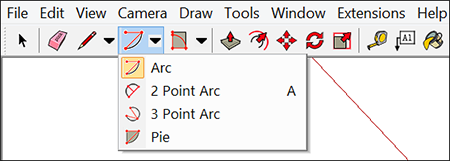
Before you begin drawing arcs, here are a few handy details about the way arc entities work:
- An arc contains multiple connected line segments, but you select and edit an arc as a single entity.
- An arc can define the edge of a face and divide a face.
- Although an arc is one entity, the SketchUp inference engine sees all the segments that make up the arc and highlights any geometric point if you hover your cursor over one.
- You can tell SketchUp how many segments to use in an arc entity. The default is 12 segments. The more segments you use, the more complex your arc becomes and the harder SketchUp has to work to display your model. Fewer than 12 segments keep your model simple, but the arc may look blocky.
The following video introduces how you draw with the rainbow of arc tools and each tool's golden secrets. Or read on for details about drawing with each arc tool.
Table of Contents
- Drawing with the 2 Point Arc tool
- Drawing with the Arc and Pie tools
- Drawing with the 3 Point Arc tool
- Editing an arc entity
Drawing with the 2 Point Arc tool
When you draw an arc with the 2 Point Arc tool, you set the starting point, the ending point, and the bulge distance. The distance between the starting point and the ending point is also known as the chord length.
To draw a 2-point arc, follow these steps:
- Select the 2 Point Arc tool (
 ). The cursor changes to a pencil with an arc.
). The cursor changes to a pencil with an arc. - Click to place the starting point of your arc. The Measurements box is ready to accept a Length value.
- Move the cursor to the ending point of your chord. (Press the Esc key at any point during the operation to start over.)
- Click to place the ending point. Or type a length value and press Enter. A straight line is created. The Measurements box changes to accept a Bulge value.
- Move your cursor perpendicular to the straight line to adjust the bulge distance. If you want to draw a half circle, watch for the half-circle inference, as shown in the figure. The inference tells you when the arc is a half-circle.

- Click to set the bulge distance. You can also type a value, such as 5' or 7mm, and press Enter or Return.
Note: If you wish to repeat this operation precisely, for example if you're rounding all 4 corners on a rectangle, you can simply move your cursor to each corner and then double-click it'll repeat the previous arc parameters and even clean our the excess waste.
Tip: Immediately after you draw a 2-point arc, you can change the bulge, radius, or number of segments with the Measurements box. Remember that you don't need to click in the Measurements box first; simply type a value and press Enter or Return. Here's how to change each value:
- Bulge distance: After you finish creating a 2-point arc, the Measurements box is ready to accept a Bulge value by default. Simply type the value and units (if different from the default units in your template).
- Radius: You can specify an arc radius instead of a bulge distance. Type the desired radius in the Measurements box and add the letter R for radius. For example: 24r or 3'6"r or 5mr
- Number of segments: Type a number and followed by the letter S for segments. For example: 20s
Drawing with the Arc and Pie tools
The Arc tool and the Pie tool are handy when you need to know your arc's angle, rather than a bulge or radius. The Arc tool draws an open arc, and the Pie tool draws a closed, pie-shaped arc.
To create an arc with the Arc or Pie tool, follow these steps:
- Select the Arc tool (
 ) or the Pie tool (
) or the Pie tool ( ). The cursor changes to a pencil with an open arc or a closed arc, respectively, and a half-circle protractor indicates the orientation of a drawing plane.
). The cursor changes to a pencil with an open arc or a closed arc, respectively, and a half-circle protractor indicates the orientation of a drawing plane. - Click to place the center of your arc. You have locked the orientation of the drawing plane and a full-circle protractor appears, as shown in the figure.

- Move the cursor to the starting point of your arc. Notice that the Radius value in the Measurements box changes dynamically as you move the cursor. If you like, you can type a number and unit and the press Enter to set a precise radius value.
- Click to place the starting point of your arc. A straight dotted line that represents the radius of your arc appears, as shown in the figure. Notice that the Measurements box changes to accept an Angle value.
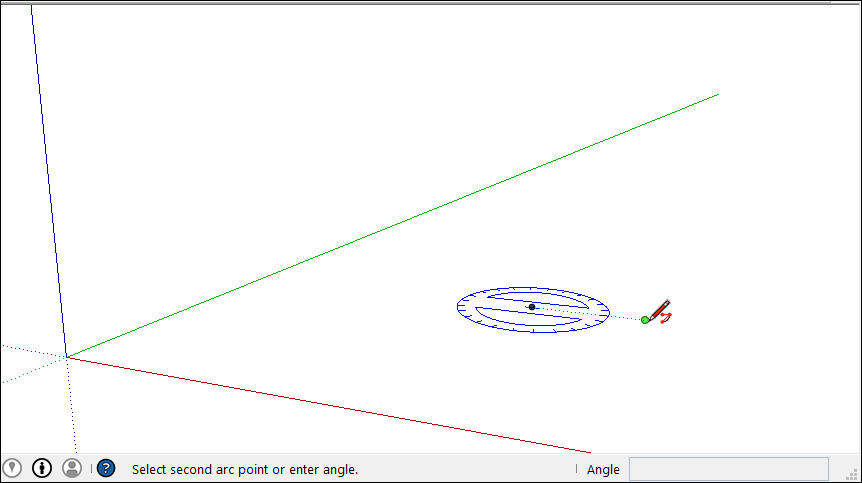
- Move the cursor to the ending point of your arc.
- Click to place the ending point of your arc or type an angle value and press Enter or Return. SketchUp creates an open arc if you used the Arc tool, or a pie-shaped face if you use the Pie tool. The following figure shows an open arc on the left and a pie shape on the right.

When you draw an arc with the Arc or Pie tool, by default, the arc is drawn with a fixed number of line segments that grow or shrink in length, depending on the completeness of the arc. You can change the number of line segments or base the arc on circle segments instead (that is, the number of segments it would take for the arc to form a complete circle).
- To change the number of line segments: Immediately after drawing the arc, type the number of sides you want and the letter S for sides. Then press Enter or Return. For example, typing 10s creates an arc with 10 line segments. Another method is to press the Ctrl + (Microsoft Windows) or Option + (macOS) to increase the number of segments. Going the other direction, Ctrl - (Microsoft Windows) or Option - (macOS) will decrease the number of lines. If you're using a French Canadian keyboard, hold down the Ctrl key (Microsoft Windows) and the +/= key to increase the segments. For macOS, press Command and = to increase segments or - to decrease segments.
- To base your arc on circle segments: Immediately after drawing the arc, type the number of circle sides and the letter C for circle. Then press Enter or Return. For example, typing 20c tells SketchUp to base your arc on a 20-sided circle.
Drawing with the 3 Point Arc tool
When you use the 3 Point Arc tool, you draw the arc based on a pivot point. Follow these steps to use the 3 Point Arc tool:
- Select the 3 Point Arc tool. The cursor changes to a pencil with an arc.
- Click to establish a starting point of the arc.
- Move the cursor away from the starting point.
- Click again to establish the second point. A small dot appears, which is a pivot point for the arc.
- Move the cursor away from the dot. An arc appears as your move the cursor.
- When you like the shape of your arc, click to finish creating the arc.
Note: Press the ESC key at any point during the operation to start over.
Editing an arc entity
You can edit the radius of an arc entity by using the Move tool or the Entity Info dialog box. With the Move tool ( ) selected, you can edit an arc entity as follows:
) selected, you can edit an arc entity as follows:
- Adjust the midpoint: Hover the Move tool's cursor to locate the midpoint of the arc. Then click and drag to adjust the arc, as shown in the figure.
- Move an end point: Click and drag an arc's end point to adjust the arc's length and radius.
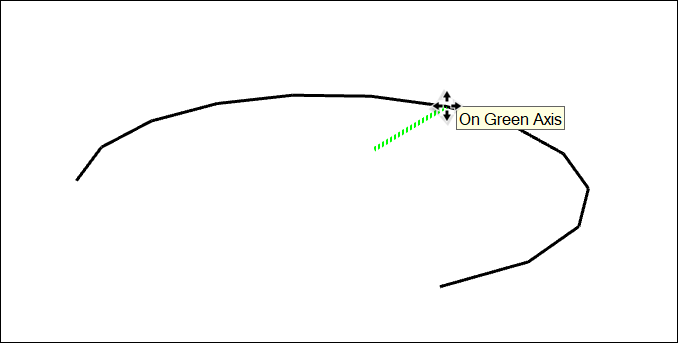
You can also adjust the radius and number of segments using the Arc entity's Entity Info panel. Context-click the arc you want to edit. From the menu that appears, choose Entity Info. In the Entity Info panel shown here, simply type a new value for the radius or number of segments.
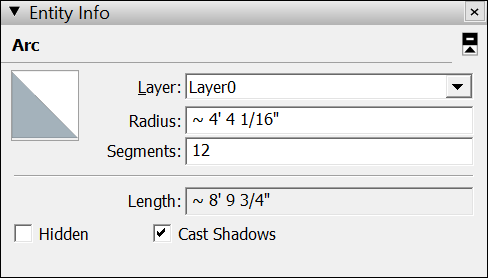
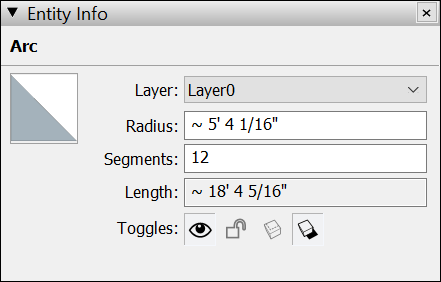
Warning: If an Arc is transformed in a way that destroys its radial definition, such as with a non-uniform scale operation, you can no longer edit the entity as an arc. At that point, the arc behaves like a freehand shape.
When you use the Push/Pull tool to extrude a 2D face that includes an arc, SketchUp extrudes a special surface entity whose radius can also be edited. Use the Move tool to reposition the midpoint edge, and the all the geometry that makes up the extruded arc will move accordingly, as shown in the figure.

How to Draw an Arc in Tikz Latex
Source: https://help.sketchup.com/es/sketchup/drawing-arcs